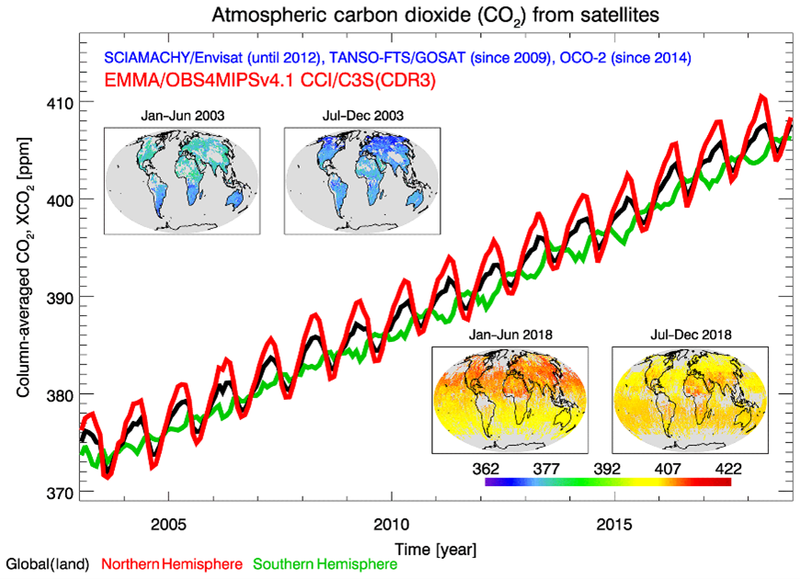Working with Obs4MIPs to make ESA CCI products available for model intercomparison projects (MIPs)
Key Highlights
Obs4MIPs encourages use of CCI datasets in a wide range of research
- Obs4MIPs is a climate model community initiative to encourage widespread uptake of satellite observations for climate model verification and development.
- CMUG is supporting the CCI projects to contribute their data to Obs4MIPs, these datasets include:
- Aerosol
- Sea Surface Temperature (SST)
- Cloud
- Carbon Dioxide (CO2)
- Methane
These data can now be easily compared to CMIP6 data and to other Obs4MIPs datasets facilitating their use in high profile publications such as IPCC reports which draw heavily on results from CMIP in their assessments.
Background
Obs4MIPs[1] products are mature, well documented, easy to access and provided in a standard format [1]. This encourages their uptake by removing many of the common barriers to use of satellite data in research [2].
The Obs4MIPs products are formatted and organised according to the model output requirements of the WCRP's Coupled Model Intercomparison Project (CMIP) [3]. They are made available on the Earth System Grid Federation (ESGF) with the archive of CMIP model output data, so that both observations and model output are searchable via the same portals. Each Obs4MIPs observational dataset corresponds to a biogeophysical field that is output by a climate model in one or more of the CMIP experiments. This technical alignment of observational products with climate model output can enable model evaluation, development and research.
[1] https://esgf-node.llnl.gov/projects/obs4mips/
Use of CCI data through Obs4MIPs
A number of publications have used the CCI data from the obs4MIPs portal, e.g., CO2 [4], methane [5]. Most of these also utilise the ESMValTool (see briefing note on ESMValTool). An example of the data used is shown in Figure 1 from [5].

References
[1] Waliser, D., Gleckler, P. J., Ferraro, R., Taylor, K. E., Ames, S., Biard, J., Bosilovich, M. G., Brown, O., Chepfer, H., Cinquini, L., Durack, P. J., Eyring, V., Mathieu, P.-P., Lee, T., Pinnock, S., Potter, G. L., Rixen, M., Saunders, R., Schulz, J., Thépaut, J.-N., and Tuma, M.: Observations for Model Intercomparison Project (Obs4MIPs): status for CMIP6, Geosci. Model Dev., 13, 2945–2958, https://doi.org/10.5194/gmd-13-2945-2020, 2020.
[2] Maria Teresa Miranda Espinosa, Gregory Giuliani & Nicolas Ray (2020) Reviewing the discoverability and accessibility to data and information products linked to Essential Climate Variables, International Journal of Digital Earth, 13:2, 236-252, DOI: 10.1080/17538947.2019.1620882
[3] https://www.wcrp-climate.org/wgcm-cmip
[4] Gier, B. K., Buchwitz, M., Reuter, M., Cox, P. M., Friedlingstein, P., and Eyring, V.: Spatially resolved evaluation of Earth system models with satellite column-averaged CO2, Biogeosciences, 17, 6115–6144, https://doi.org/10.5194/bg-17-6115-2020, 2020.
[5] Reuter, M., Buchwitz, M., Schneising, O., Noël, S., Bovensmann, H., Burrows, J. P., Boesch, H., Di Noia, A., Anand, J., Parker, R. J., Somkuti, P., Wu, L., Hasekamp, O. P., Aben, I., Kuze, A., Suto, H., Shiomi, K., Yoshida, Y., Morino, I., Crisp, D., O'Dell, C. W., Notholt, J., Petri, C., Warneke, T., Velazco, V. A., Deutscher, N. M., Griffith, D. W. T., Kivi, R., Pollard, D. F., Hase, F., Sussmann, R., Té, Y. V., Strong, K., Roche, S., Sha, M. K., De Mazière, M., Feist, D. G., Iraci, L. T., Roehl, C. M., Retscher, C., and Schepers, D. (2020): Ensemble-based satellite-derived carbon dioxide and methane column-averaged dry-air mole fraction data sets (2003–2018) for carbon and climate applications, Atmos. Meas. Tech., 13, 789–819, https://doi.org/10.5194/amt-13-789-2020.
About the author

This article was produced in 2022 by Dr Amy Doherty at the Met Office. Amy is the CMUG project manager. She works on climate risk engagement and outreach in the International Applied Science and Services are of the Met Office. She has a Ph.D. in remote sensing and previously worked on improving the use of satellite data in the Met Office operational weather forecasts, with a focus on microwave humidity sounders.

